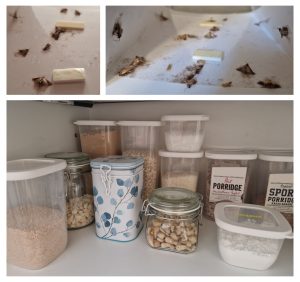A Blog post by Theresa Szemethy
“It can happen to anyone”, but … I never thought it would happen to me!
After all, I’ve been with Jesmond for over 6 years and have read, learned and even written articles about almost every harmful insect (pest). And yet, I recognized the signs too late. My food hoarding and not using it up caused my first moth infestation.
A few months before D-day, I noticed solitary moths in different rooms of my apartment. I couldn’t pinpoint a favourite resting spot, so I figured they came from outside. That is theoretically possible, but in a retro-perspective view, too optimistic. And I knew I would have the right insecticide, Clean Kill, handy anytime if they annoyed me too much. While I admit not having done a fully blown investigation, I haven’t identified a specific source of the moths just yet. Still, I started worrying and wanted to know how many food robbers were around in the apartment.
Thus, I set up a few monitor bait traps and caught some after a few weeks. But, silly me, I have not yet gone into full defending mode. As I initially suspected the victims to be cloth moths, it turned out to be a far more invasive species: Food moths. Due to my previous research and deep dive into the different species of moths, I could easily recognize the so-called Indian meal moth (Plodia interpunctella). But, can you believe it, even after this realization, it didn’t occur to me looking for their nest. I still have to smack myself on the wrist as I relive the incident! In my defence, I went to my pantry and looked superficially through my stores to see if anything caught my eye. As nothing seemed to appear out of order, I dismissed the thought of an infestation.
Only a few weeks later, when I went to take something from my food store, and a moth had the boldness to fly right at me, it finally dawned on me that I had a problem. That triggered a frantic, panicked reaction! While I enjoy entertaining in my apartment, these little dusty creepy crawlies were not welcomed. But my survival mode kicked in, and I dug up all the moth knowledge I had acquired over the years. I knew exactly what life stages a moth goes through, what they look like and what to look for in food. So, I carefully and insistently examined, checked, opened and looked inside every open rice, pasta, flour and nut package. I can’t remember a time when I scrutinized my food packages so intensely to see if I was greeted by a larva wriggling through the contents like a tiny disgusting worm.
The source was finally located in a pile of biological-grown dried fruit and nuts packages that had not been unattended for far too long. There, they were in all metamorphosis stages! Adult moths and larvae inside and outside the packages, a found paradise and theme park for the Indian meal moth. If I had known then that I would write a blog about it, I would have definitely taken a before and after photo to document my story vividly. BUT you can google it. 😉
At the end, and 100 goosebumps of horror and 3 full garbage bags later, the supply shelf was empty. All adult moths in every crack were eliminated, and everything was clean, disinfected, and coated with Clean Kill for long-term protection.
Storing too much food did NOT pay off, as I had to dispose of about 90% of the goodies on that shelf. But I was reminded of a valuable lesson over again: Never leave food as an invitation in open packages, but use air-tight storage cans/containers.
I was pretty paranoid the days after and still carefully checked the walls and food supplies. There were still adult moths sitting on the kitchen walls every day. They were even so cheeky and wanted to make up for the loss of their offspring by mating in front of me. Not with me! They all got to feel my wrath, either by death through manual crushing or otherwise by the clean but targeted stream of Clean Kill.
After I cleaned out everything again a week later, removing pupated larvae and spraying the shelf with Clean Kill, I am confident that everything is back to normal and peace returns.
That brings me to my conclusion:
- Storage containers were ordered immediately! 😊
- Less is sometimes more, or using up food supplies more quickly.
- Thoroughly clean the supply shelf more often and spray Clean Kill.
- Take EVERY moth sighted seriously and observe thoroughly.
Clean Kill makes it convenient and easy to prevent such an infestation. Clearly, it is far easier to prevent than dealing with a fully blown infestation of this resilient insect, inflicting substantial damage.
But I’ve always been more the learning-by-doing type, so I guess I had to learn it that way, and as my colleague at work recently teased me: “There’s always a first time sometime”. 😉

© Theresa Szemethy
And if you are interested in moths, the different species and their characteristics, check out my article here: https://jesmond.com/world-of-moths/